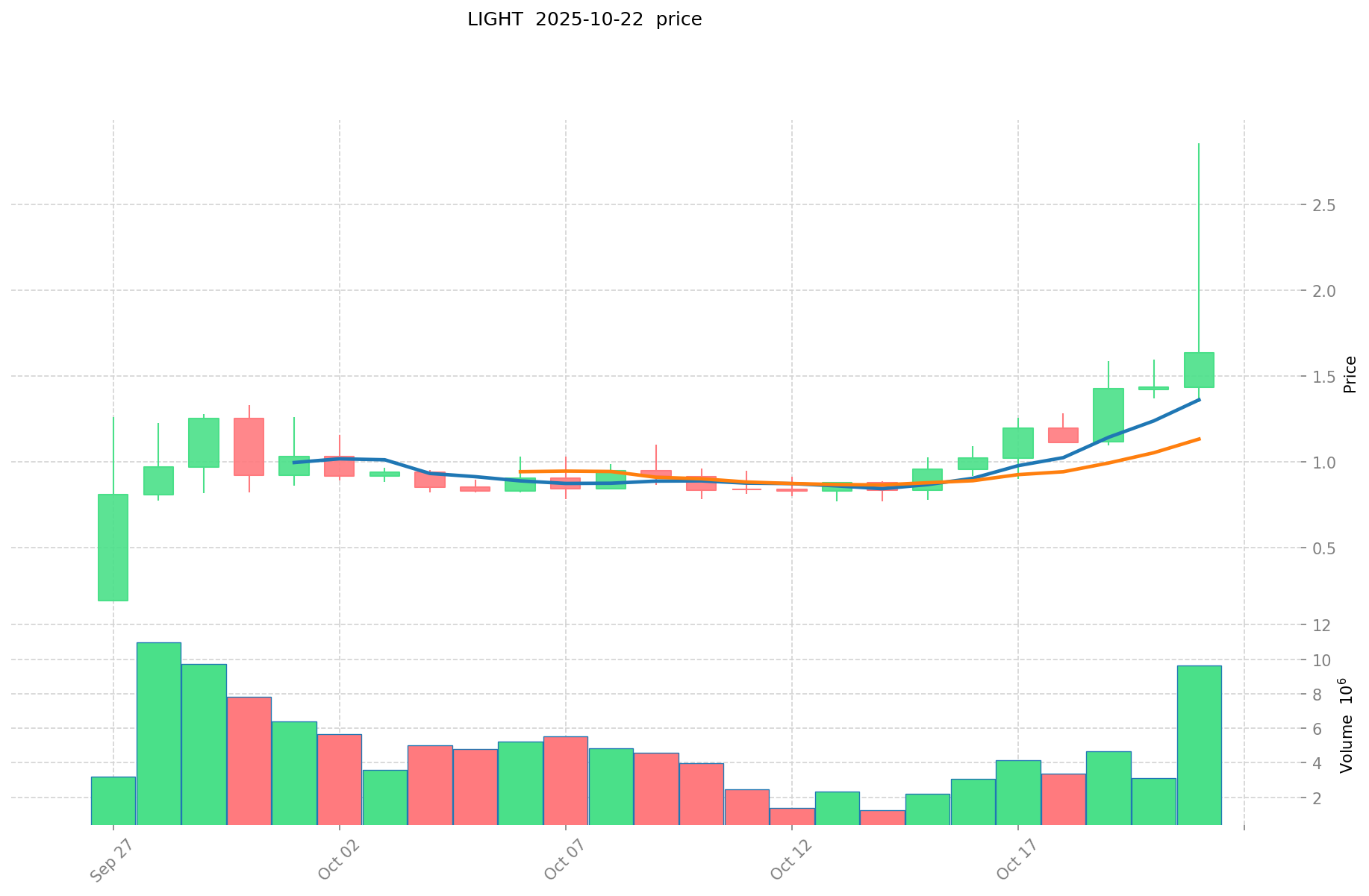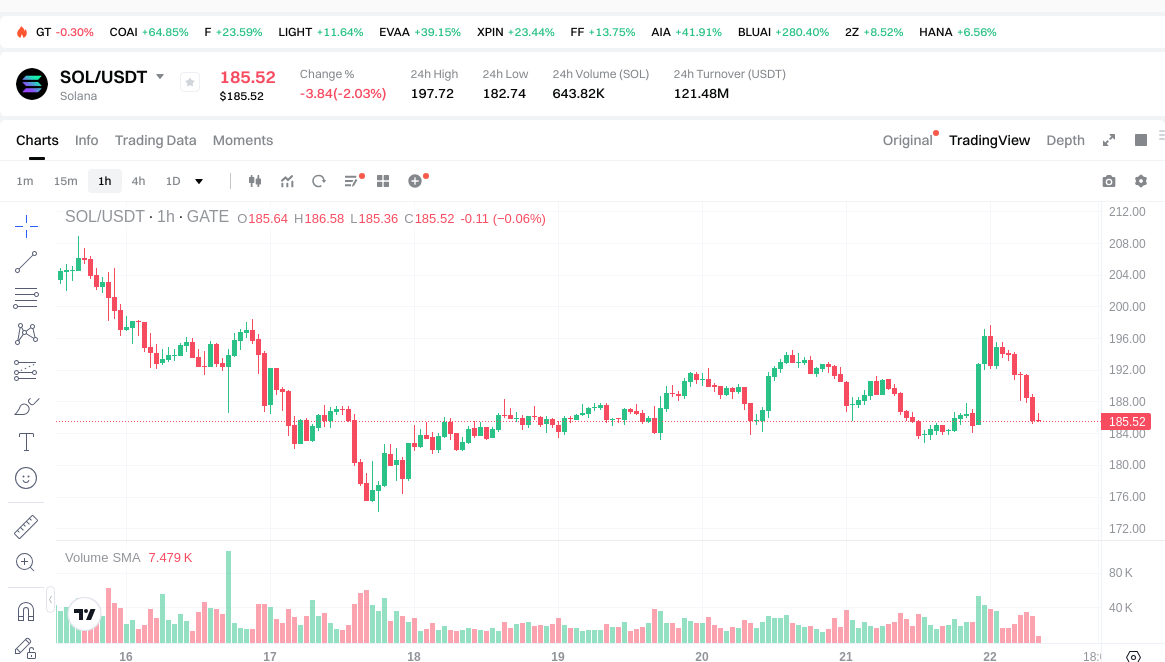LIGHT vs SOL: The Battle for Blockchain Supremacy in the Digital Age
Introduction: LIGHT vs SOL Investment Comparison
In the cryptocurrency market, the comparison between LIGHT and SOL has always been an unavoidable topic for investors. The two not only differ significantly in market cap ranking, application scenarios, and price performance, but also represent different positioning in the crypto asset space.
Bitlight Labs (LIGHT): Since its launch, it has gained market recognition for its focus on Bitcoin and Lightning Network infrastructure.
Solana (SOL): Since its inception in late 2017, it has been hailed as a high-performance blockchain protocol, becoming one of the cryptocurrencies with the highest global trading volume and market capitalization.
This article will provide a comprehensive analysis of the investment value comparison between LIGHT and SOL, focusing on historical price trends, supply mechanisms, institutional adoption, technological ecosystems, and future predictions, attempting to answer the question most concerning to investors:
"Which is the better buy right now?"
I. Price History Comparison and Current Market Status
LIGHT and SOL Historical Price Trends
- 2025: LIGHT launched and experienced significant price volatility.
- 2025: SOL continued to see strong growth due to increasing adoption of the Solana ecosystem.
- Comparative analysis: In the current market cycle, LIGHT reached an all-time high of $2.8558 before dropping to a low of $0.19, while SOL has shown more stability, trading between $182.74 and $197.72 in the past 24 hours.
Current Market Situation (2025-10-22)
- LIGHT current price: $1.6271
- SOL current price: $186.01
- 24-hour trading volume: LIGHT $18,426,739 vs SOL $121,781,294
- Market Sentiment Index (Fear & Greed Index): 34 (Fear)
Click to view real-time prices:
- View LIGHT current price Market Price
- View SOL current price Market Price


Investment Value Analysis: LIGHT vs SOL
I. Core Factors Influencing LIGHT and SOL Investment Value
Technical Architecture Comparison
- Solana: Utilizes Proof of History (PoH) consensus mechanism, enabling high throughput (thousands of transactions per second) with very low fees
- Performance Metrics: Solana's technical design prioritizes speed and efficiency through its unique architecture
- Network Reliability: Recent upgrades like Alpenglow have improved transaction throughput and confirmation speed
Ecosystem Development and Growth
- Solana Ecosystem: Experiencing rapid growth across DeFi, NFTs, and meme coins
- User Engagement: Chain activity metrics show significant user return and increased on-chain activity
- Developer Adoption: Technical advantages have attracted substantial developer interest
Market Positioning
- Solana: Positioned as Ethereum's primary challenger with significant institutional interest
- Market Sentiment: Positive shift in market sentiment following recovery from FTX collapse
- Market Resilience: SOL price stability above $200 demonstrates strong market confidence
Staking Economics
- Solana Staking: As of recent data, nearly 67% of total SOL supply is staked
- Staking Distribution: Mix of retail investors, DeFi protocols, and institutional players
- Yield Structure: Current staker annual return approximately 6.3%
II. Institutional Adoption and Market Applications
Institutional Holdings
- Institutional Interest: According to Strategy Solana Reserve data, 17 entities have established Solana treasuries
- Corporate Treasury: Approximately 17.11 million SOL held in corporate treasuries
- Financial Products: CME Group planning to launch Solana futures options to facilitate institutional investment
Technical Innovation Pipeline
- SVM Extension: Efforts to bring Solana Virtual Machine to other chains including BNB and BASE
- Cross-Chain Compatibility: Technical improvements focused on seamless ecosystem interoperability
- Mobile Development: Solana's focus on mobile integration creates additional adoption vectors
Market Maturity Indicators
- Transaction Volume: Gas fees generating millions in revenue, indicating genuine network utility
- Project Quality: Growing number of sustainable projects with proven business models
- Community Engagement: Strong community participation in governance and platform activities
III. Investment Risk Assessment
Project Evaluation Framework
- Team Credentials: Assess team experience and track record of delivery
- Product Development: Evaluate actual product implementation vs. roadmap promises
- Code Quality: Check for open-source code and third-party security audits
- Tokenomics: Examine token distribution model and team allocation percentages
- Community Health: Analyze community discussion quality focusing on technical progress rather than price speculation
Technical Limitations
- Scalability Challenges: Network congestion issues during peak usage periods
- Architecture Constraints: SVM design initially developed for monolithic networks rather than modular systems
- Technical Upgrades: Ongoing efforts to improve SVM architecture to enhance cross-ecosystem operability
Competitive Landscape
- EVM vs. SVM: Competition between execution environments is driving innovation
- Developer Ecosystem: Solana's Rust-based development environment provides performance advantages but requires specific expertise
- Market Differentiation: Solana's competitive edge lies in transaction speed and fee structure
IV. Future Development Perspectives
Technical Roadmap
- Horizontal Scaling: Implementation of "Decoupled SVM" concept to achieve horizontal performance scaling
- Integration Capabilities: Efforts to support various consensus mechanisms and optimize resources
- Layer 2 Solutions: Work on integrating with mainstream Layer 2 stacks like OP Stack
Adoption Catalysts
- Macroeconomic Environment: Interest rate policies affecting overall market risk appetite
- Institutional Infrastructure: Development of standardized investment tools increasing institutional accessibility
- User Experience: Focus on reducing barriers to entry for mainstream users
Market Indicators to Monitor
- Developer Activity: Growth in number of active developers and projects
- Transaction Metrics: Sustained growth in daily active users and transaction volume
- Institutional Inflows: Tracking professional investment interest through treasury holdings and derivatives trading
III. 2025-2030 Price Prediction: LIGHT vs SOL
Short-term Prediction (2025)
- LIGHT: Conservative $0.94-$1.62 | Optimistic $1.62-$2.36
- SOL: Conservative $145.05-$185.96 | Optimistic $185.96-$252.91
Mid-term Prediction (2027)
- LIGHT may enter a growth phase, with expected prices ranging from $1.84 to $3.36
- SOL may enter a consolidation phase, with expected prices ranging from $124.42 to $241.92
- Key drivers: Institutional capital inflow, ETF, ecosystem development
Long-term Prediction (2030)
- LIGHT: Base scenario $2.70-$3.56 | Optimistic scenario $3.56-$4.98
- SOL: Base scenario $238.82-$291.24 | Optimistic scenario $291.24-$428.13
Disclaimer: This prediction is for informational purposes only and should not be considered as financial advice. Cryptocurrency markets are highly volatile and unpredictable. Always conduct your own research before making any investment decisions.
LIGHT:
| 年份 | 预测最高价 | 预测平均价格 | 预测最低价 | 涨跌幅 |
|---|---|---|---|---|
| 2025 | 2.359068 | 1.6158 | 0.937164 | 0 |
| 2026 | 2.7824076 | 1.987434 | 1.37132946 | 22 |
| 2027 | 3.362738328 | 2.3849208 | 1.836389016 | 46 |
| 2028 | 3.39111888552 | 2.873829564 | 2.70139979016 | 76 |
| 2029 | 3.9782422654452 | 3.13247422476 | 2.975850513522 | 92 |
| 2030 | 4.97750154314364 | 3.5553582451026 | 2.702072266277976 | 118 |
SOL:
| 年份 | 预测最高价 | 预测平均价格 | 预测最低价 | 涨跌幅 |
|---|---|---|---|---|
| 2025 | 252.9056 | 185.96 | 145.0488 | 0 |
| 2026 | 241.37608 | 219.4328 | 212.849816 | 17 |
| 2027 | 241.924662 | 230.40444 | 124.4183976 | 23 |
| 2028 | 337.71530793 | 236.164551 | 127.52885754 | 26 |
| 2029 | 295.54812734895 | 286.939929465 | 177.9027562683 | 54 |
| 2030 | 428.12872175825325 | 291.244028406975 | 238.8201032937195 | 56 |
IV. Investment Strategy Comparison: LIGHT vs SOL
Long-term vs Short-term Investment Strategies
- LIGHT: Suitable for investors focused on Bitcoin and Lightning Network infrastructure development
- SOL: Suitable for investors seeking exposure to a high-performance blockchain ecosystem with diverse applications
Risk Management and Asset Allocation
- Conservative investors: LIGHT: 30% vs SOL: 70%
- Aggressive investors: LIGHT: 50% vs SOL: 50%
- Hedging tools: Stablecoin allocation, options, cross-currency portfolios
V. Potential Risk Comparison
Market Risk
- LIGHT: Higher volatility due to lower market cap and trading volume
- SOL: Susceptibility to broader crypto market trends and sentiment shifts
Technical Risk
- LIGHT: Scalability, network stability
- SOL: Network congestion during peak usage, potential vulnerabilities in smart contracts
Regulatory Risk
- Global regulatory policies may impact both differently, with SOL potentially facing more scrutiny due to its broader ecosystem and DeFi applications
VI. Conclusion: Which Is the Better Buy?
📌 Investment Value Summary:
- LIGHT advantages: Focus on Bitcoin ecosystem, potential for growth in Lightning Network adoption
- SOL advantages: Established ecosystem, high performance, institutional interest
✅ Investment Advice:
- Novice investors: Consider a higher allocation to SOL due to its established market position
- Experienced investors: Balanced approach with exposure to both LIGHT and SOL
- Institutional investors: SOL may be more attractive due to liquidity and ecosystem maturity
⚠️ Risk Warning: The cryptocurrency market is highly volatile. This article does not constitute investment advice. None
VII. FAQ
Q1: What are the main differences between LIGHT and SOL? A: LIGHT focuses on Bitcoin and Lightning Network infrastructure, while SOL is a high-performance blockchain protocol with a diverse ecosystem. SOL has a larger market cap, higher trading volume, and a more established position in the crypto market.
Q2: Which cryptocurrency has shown better price stability? A: Based on the provided data, SOL has demonstrated better price stability. While LIGHT experienced significant volatility, ranging from $0.19 to $2.8558, SOL has been trading in a narrower range between $182.74 and $197.72 in the past 24 hours.
Q3: How do the ecosystems of LIGHT and SOL compare? A: SOL has a more developed ecosystem with rapid growth across DeFi, NFTs, and meme coins. It has attracted significant developer interest and institutional adoption. LIGHT's ecosystem is more focused on Bitcoin and Lightning Network infrastructure.
Q4: What are the key technical advantages of Solana? A: Solana utilizes a Proof of History (PoH) consensus mechanism, enabling high throughput (thousands of transactions per second) with very low fees. Recent upgrades like Alpenglow have improved transaction throughput and confirmation speed.
Q5: How do institutional investors view LIGHT and SOL? A: SOL has garnered more institutional interest, with 17 entities establishing Solana treasuries holding approximately 17.11 million SOL. Additionally, financial products like CME Group's planned Solana futures options are being developed to facilitate institutional investment. LIGHT's institutional adoption is not as prominent based on the provided information.
Q6: What are the long-term price predictions for LIGHT and SOL? A: By 2030, LIGHT is predicted to reach $2.70-$3.56 in a base scenario and $3.56-$4.98 in an optimistic scenario. SOL is expected to reach $238.82-$291.24 in a base scenario and $291.24-$428.13 in an optimistic scenario.
Q7: Which cryptocurrency might be more suitable for different types of investors? A: For novice investors, SOL may be more suitable due to its established market position. Experienced investors might consider a balanced approach with exposure to both LIGHT and SOL. Institutional investors may find SOL more attractive due to its liquidity and ecosystem maturity.
Q8: What are the main risks associated with investing in LIGHT and SOL? A: LIGHT faces higher volatility due to its lower market cap and trading volume, as well as potential scalability and network stability issues. SOL is susceptible to broader crypto market trends, network congestion during peak usage, and potential smart contract vulnerabilities. Both face regulatory risks, with SOL potentially facing more scrutiny due to its broader ecosystem and DeFi applications.
Share
Content